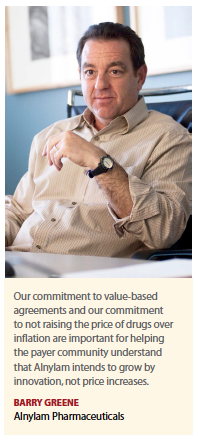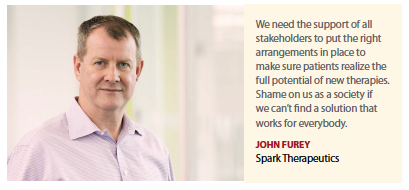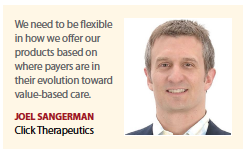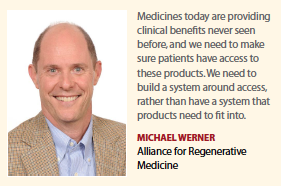We are in an era of unprecedented innovation. Gene and cancer immunotherapies, RNAi therapies, smart medicines and digital therapies, as well as a whole host of other innovative remedies still in the pipeline, are treating and even curing life-threatening diseases.
But these innovations often come with unprecedented costs and are challenging our current healthcare system. The current system of health insurance that is based on unit pricing is not set up to address high-cost, and sometimes one-time, cell and gene therapies, or therapies such as digital “medicines" that have been clinically validated to demonstrate a change in behavior.
Additionally, current pricing practices create a conflict between drug companies and other healthcare stakeholders, EY finds. The current pricing model is under threat because of the misalignment between when drug costs occur and when benefits are realized.
Pricing approaches in the future will require companies to work with other stakeholders, especially payers, to create more effective ways to ensure access to the new innovations expected to come to market.
“We have a system now that pays for chronic treatment, for palliative care, and for per-interaction with the patient," says Michael Werner, senior counsel and co-founder, Alliance for Regenerative Medicine (ARM). “For new technologies we’re going to need to develop a value-based payment system. We are already seeing evidence that this is starting to happen."
For example, the Centers the Medicare & Medicaid Services has developed  quality measures for Medicare doctors in hospitals to financially incentivize them to provide evidence-based care. Insurers have been pushing back against high-cost therapies, asking manufacturers to provide evidence on outcomes. Pharma companies, insurers, and healthcare providers are having discussions around the value of new therapies.
quality measures for Medicare doctors in hospitals to financially incentivize them to provide evidence-based care. Insurers have been pushing back against high-cost therapies, asking manufacturers to provide evidence on outcomes. Pharma companies, insurers, and healthcare providers are having discussions around the value of new therapies.
Industry leaders say this is an important start. Aligning value and price is a positive, but determining value is complicated and open to debate. Biopharma companies and other organizations, such as the Institute for Clinical and Economic Review and the Innovation and Value Initiative, are trying to find common ground on measuring value.
Another example of forward movement is that outcomes-based contracts with health plans are increasing, according to a recent survey of health plans by Avalere. In fact, among survey respondents, 25% of plans have such contracts in place; 85% of them are considering additional contracts. An additional one-third of plans are considering an outcomes-based contract.
Most outcomes-based contracts, according to respondents surveyed by Avalere, address three common therapeutic areas: cardiovascular disease, infectious diseases, and oncology.
In cardiovascular disease and infectious disease (namely hepatitis C), outcomes have generally been clearly defined, which lend themselves to outcomes-based contracts. And while in oncology, metrics for outcomes-based contracts have not been as well established, plans are exploring them as a way to help balance access and cost.
Despite some initial progress, we still talk about drug costs or costs to the healthcare system in a very siloed way, says Leslie Isenegger, principal strategist, reputation and risk management practice, Syneos Health.
“We need to think about the impact of health economic assessments on the bigger picture, including how to capture the benefits of the innovation to patients, to their families, their communities, and the larger society both through cost offsets for direct and indirect medical care," she says.
“It’s harder to quantify the intangible benefits such as increased productivity of patients, increased productivity for caregivers who don’t have to drop out of the  workforce, greater educational attainment for people, general improvement in the quality of life, but we are starting to build these metrics into the value picture," she continues.
workforce, greater educational attainment for people, general improvement in the quality of life, but we are starting to build these metrics into the value picture," she continues.
Ms. Isenegger says the challenge is obvious — how can the system afford to discover, develop, and deliver precision therapies for more and more people who are living longer and therefore remain on treatment longer because they’re being diagnosed earlier.
“We need to shift the mindset around reimbursement," she says. “For years, treatments have focused on managing symptoms and not addressing the underlying cause of disease. Chronic diseases were treated with chronic therapies and paid for year over year across a person’s lifetime. Our current system doesn’t account for a health plan to pay up front for a lifetime’s worth of benefits, particularly when patients tend to change health plans every few years."
Leading experts say the insurance and reimbursement system will have to change to accommodate new innovations and that there won’t be just one model for financing innovative therapies.
A one-size-fits-all approach is unlikely to meet the needs of all stakeholders or provide access to the innovations that are expected to come to market in the near future. In the meantime, pharma companies are starting to form multi-stakeholder collaborations that create new models for delivering innovative therapies to patients.
“There is no perfect way to do this," Mr. Werner says. “The big message that shouldn’t be lost is that we’re having these conversations and that payers and developers are trying to figure out how to move forward. There’s a recognition that we’re talking about clinical benefits never seen before and we need to make sure patients have access to these products. We need to build a system around access, rather than have a system that products need to fit into."
Working Together for Better Outcomes
Biopharmaceutical companies, payers, and providers are working together to find a new structure that allows patients to realize the benefit from new  therapies. They are forming unique reimbursement and contracting structures that aim to address the needs of patients, while making it financially feasible for payers.
therapies. They are forming unique reimbursement and contracting structures that aim to address the needs of patients, while making it financially feasible for payers.
A common theme among these arrangements is outcomes- and value-based contracting, even for digital medicines.
These programs are often in place when a new therapy receives approval from the Food and Drug Administration, and industry executives say it’s critical to have data about outcomes and economic benefits when working with payers.
One company paving the way in the area of innovative payer agreements is Spark Therapeutics. In December 2017, the company received approval for Luxturna, a one-time gene therapy for patients with a rare genetic disease. It is an adeno-associated virus vector-based gene therapy for patients with biallelic RPE65 mutation-associated retinal dystrophy, a form of blindness that affects 1,000 to 2,000 people in the United States. The therapy was priced at $850,000 for treatment in both eyes.
Spark Therapeutics announced during its second-quarter 2018 earnings call in August that it had shipped 12 vials in the second quarter of 2018 and that patients have now been given the medication in six treatment centers. One vial treats one eye, and general practice has been to treat both eyes. During the first half of 2018, the company shipped 18 vials.
Spark also announced that about 80% of commercial lives had medical policy coverage in line with FDA-approved labeling as of June 30, 2018.
The company has signed insurance contracts with three of the largest national health plans and three important Blues plans, which collectively represent more than 50% of commercial lives.
In addition, an estimated 75% of the patients treated during the second quarter of 2018 were covered using its innovative payment and distribution models.
Spark Therapeutics offers an innovative contracting model and outcomes-based rebates in the United States. The contracting model supports patient access  while reducing costs to payers and the financial burden and risk of traditional “buy and bill" models for treatment centers. The outcomes-based rebate offers both a short-term (30-90 days) and a longer-term (30 month) durability measure unique to this one-time therapy.
while reducing costs to payers and the financial burden and risk of traditional “buy and bill" models for treatment centers. The outcomes-based rebate offers both a short-term (30-90 days) and a longer-term (30 month) durability measure unique to this one-time therapy.
Spark Therapeutics also has reached an agreement with affiliates of Express Scripts using this contracting model.
Spark Therapeutics has reached an agreement with Harvard Pilgrim to make Luxturna available under the outcomes-based rebate arrangement and the innovative contracting model that aims to reduce risk and financial burden for payers and treatment centers.
Leaders at Spark recognized that a gene therapy that was a single treatment would require a very different approach, from a diagnostics perspective, from a medical perspective, and from a commercial perspective. Spark designated a network of Centers for Ocular Gene Therapy Treatment Centers around the country to administer the therapy.
“We strategically established these centers of excellence geographically so patients could receive the treatment and manage and optimize their care," says John Furey, chief operating officer, Spark Therapeutics. “The centers’ ophthalmology specialists, whether they are retinal specialists, pediatric ophthalmologists, or community ophthalmologists provide very specialized care and treatment during and after the course of the injection of Luxturna into the retina."
Under the outcomes-based rebate model, if the product doesn’t perform as expected, Spark Therapeutics will provide rebates to payers.
“We have agreed to rebates within a standard discount, which would not trigger best-pricing arrangements," he says. “We agreed to performance targets at 30 to 90 days, which would be the time in which the patient is expected to see the initial impact. We’ve also agreed to another time point of 30 months to check on the durability of Luxturna. If we don’t meet the thresholds that are described, then we will provide a rebate to the health plan for nonperformance."
Under the innovative contracting model, the company has worked with payers to provide an option for a direct contracting arrangement with an insurer, where the insurer would buy the product at wholesale acquisition cost. The insurer  would independently agree with the treatment center on compensation for the care of that patient, including surgical time and other costs that may be associated with the procedure.
would independently agree with the treatment center on compensation for the care of that patient, including surgical time and other costs that may be associated with the procedure.
Additionally, Spark Therapeutics is also in discussions with the Centers for Medicare and Medicaid Services and Health and Human Services to conduct a demonstration project for Luxturna, where the company would offer commercial and government payers an installment payment option, as well as greater rebates tied to clinical outcomes.
“We’re working with payers to reduce the traditional markup associated with the buy-and-bill model, thus reducing the financial burden on payers and the treatment centers," Mr. Furey says. “This model balances the needs and the concerns of the payers with the needs and concerns of the treatment centers."
Spark Therapeutics has created the Spark Therapeutics Generation Patient Services team to support patients who are eligible for treatment as well as their caregivers. This team helps patients navigate the insurance process and provides options to support their travel and accommodation logistics. The company also helps commercially insured patients with out-of-pocket expenses related to treatment, such as co-pay assistance for commercially ensured patients. For government-insured patients, they are referred to an independent patient assistance programs for possible co-pay support.
“Our intent is that there should be zero cost to the patient for Luxturna and for their immediate follow-up care," Mr. Furey says.
Spark’s solution is brilliant, says Matt Wallach, co-founder and president of Veeva. “The company has raised the bar on innovation, and it has overcome barriers in getting the product to patients."
Despite the strategies proposed by the company, the Institute for Clinical and Economic Review, taking into account the many benefits and cost savings of regaining vision to society, such as greater productivity and reduced caregiver burden, estimates the price of Luxturna should be about $400,000. Company officials, however, have defended its pricing, and Mr. Furey says the company stands behind its therapy in terms of its risk profile and durability of effect.
Another company paving the way for innovations both in science and with payers is Alnylam Pharmaceuticals. The company’s Onpattro for the treatment of the polyneuropathy of hereditary transthyretin-mediated (hATTR) amyloidosis in adults was approved both by the FDA and the EU in August 2018. This first-of-its-kind RNA interference (RNAi) therapeutic is for a rare, inherited, rapidly progressive and life-threatening disease that can quickly lead to significant disabilities.
At the time that Alnylam announced Onpattro’s approval, it also announced that is had arranged value-based agreements with leading health insurers. The company has agreements so far with Harvard Pilgrim Health Care and other major health insurers, and is engaged in many ongoing discussions. Based on MMIT, a leading medical policy-reporting agency, these payers cover about 76% of commercial medical lives in the United States. The agreements are structured to link Onpattro’s performance in real-world use to financial terms.
“It’s our desire at Alnylam to be as innovative on the commercial side as we’ve been on the R&D side," says Barry Greene, president, Alnylam Pharmaceuticals. “We went to the insurance and payer-provider community and told them that we wanted to be part of the solution. We’ve put agreements in place that when a patient does less well than expected, then we should be paid a little bit less, and we’ve put some discounts in place using physician assessments."
Mr. Greene says he can’t speak about the specifics of the insurer agreements, but essentially, providers will assess Onpattro patients in terms of their overall symptomology, for example, their ability to walk or their autonomic dysfunction. If patients are not getting better, Alnylam will provide a discount. The company is also working with CMS to provide access to those covered by Medicare.
“Many payers have experience with the industry where value-based agreements are attempted, but they’re not meaningful for them," Mr. Greene says. “In other words, they’re very hard to process. They’re complicated, and then if in fact they kick in, there aren’t meaningful dollars back to them based on patient performance. There was a lot of skepticism when we started."
Mr. Greene believes the industry has to make a commitment to payers and patients alike.
“Our value-based agreements and our pledge to not raise the price of drugs over inflation are important to help the payer community understand that Alnylam is a business that intends to grow through innovation, not price increases," he says.
Alnylam also launched Alnylam Assist, a comprehensive support services program to help patients. Alnylam Assist offers a wide range of personalized services that include access to in-house case managers who help with verification of insurance benefits and financial support for eligible patients, and field-based patient education liaisons who offer patients education on hATTR amyloidosis.
Digital and Smart Therapies
One of the newest areas presenting opportunities — and challenges — for the healthcare system is the emergence of digital and smart therapeutics. Digital therapies present another option for patients in several disease areas, including substance abuse, smoking cessation, attention deficient disorder, as well as other neurological conditions such as anxiety, insomnia, and post-traumatic stress. Digital therapies go beyond games and behavior modification. These are clinically validated digital tools that have been evaluated to assess safety and efficacy.
Smart therapies aim to merge various “smart" devices with pharmaceutical products to improve data collection about patient adherence and provide a better experience for patients.
“Some of these digital therapy innovations are changing business models in the industry," says Joe Reynolds, research manager, Noble, a developer of patient-centric advanced drug delivery system trainers. “In the drug delivery sector, these digital therapeutics are being used to improve patient outcomes, extend treatment algorithms, and create patient value through life-cycle management. And we’re seeing business models change where companies are now being reimbursed by the value that they can create through engagement and outcomes."
Because there are few existing marketplace models for reimbursement for digital and smart therapeutics, some companies developing these types of therapeutics are approaching payers with outcomes-based payment arrangements. For example, Proteus Digital Health in August announced a multi-year collaboration with Desert Oasis Healthcare (DOHC).
This collaboration initiates a digital pathway to improved medication adherence, demonstrated improvements in clinical outcomes, and reductions in hospital admissions for DOHC patients. Proteus has conducted several clinical studies demonstrating the clinical and economic benefits of using digital medicines to improve outcomes in patients, including a successful randomized control trial in patients with uncontrolled hypertension and type 2 diabetes.
Proteus has a panel of more than 20 digital medicines that treat cardiovascular and metabolic diseases, including hypertension and diabetes being prescribed to patients in the United States.
Another smart medicine is Otsuka Pharmaceutical’s Abilify MyCite, a drug-device combination approved in November 2017, which is comprised of Otsuka’s oral aripiprazole tablets embedded with an ingestible sensor, a wearable patch, and a smartphone app. When the tablet is swallowed, the sensor, emits a signal that is detected by the patch worn on the body and then, via Bluetooth, is transferred to the Proteus cloud, where it can be accessed by physicians and patients.
The system records medication ingestion and communicates this to the patient and healthcare provider. In addition, the product can collect data on activity level, as well as self-reported rest and mood, which, with patient consent can be shared with the healthcare provider and selected members of the family and care team.
In August, Otsuka announced that it has signed an agreement to facilitate access to the Abilify MyCite system to select regional provider networks contracted through Magellan Health mental health provider network. Otsuka and Magellan Health will be better able to understand how Abilify fits within the daily lives of those with serious mental illness and their caregivers, how doctors will integrate it into their daily practice, and how patients may benefit from more information about their care.
The initial market focus for Abilify MyCite is in the Medicaid environment, says John Bardi, VP, public affairs and digital medicine business development, at Otsuka America Pharmaceutical Inc.
“We are being selective in terms of the types of payers we are speaking with," he says. “First and foremost, we are looking for providers that are a good fit for mental health. They have to have an established track record in behavioral health and a track record in the area of innovation. We are looking to work collaboratively with insurers that have a connection to or a defined network of provider networks."
Mr. Bardi says the issue for payers is how to assess a therapeutic such as Abilify MyCite and determining the evidence they need to evaluate formulary positioning.
He says as part of the effort to look at outcomes for Abilify MyCite, Otsuka has developed the Digital Medicine National Steering Board headed by David Nash, M.D., dean of the Jefferson College of Population Health at Thomas Jefferson University.
“This strategically aligned collaboration between Otsuka and Magellan Health has the aim of providing real-world evidence to demonstrate the value of this drug/device combination product over time," Dr. David Nash said in a statement.
Mr. Bardi says the board is helping Otsuka to think through any issues that could emerge as adoption barriers that could limit access to innovative therapies.
“The board is helping us think through the challenges in the evaluation space," he says. “The board is also looking at possible recommendations for categories to consider for assessing outcomes."
Another company in this area is Click Therapeutics, whose lead prescription program is entering into a multi-center, randomized, controlled, parallel-group Phase III FDA registration trial for the treatment of major depressive disorder in adults.
The company is also developing therapeutics for insomnia, acute coronary syndrome, and chronic pain. Click will seek FDA clearance for these programs as class II medical devices with disease-specific treatment claims, to be prescribed by physicians and reimbursed by payers.
“There are a lot of examples where agents other than small or large molecules can drive treatment outcomes," says Joel Sangerman, chief commercial officer, Click Therapeutics.
In randomized, controlled trials, Click’s depression program has been shown to be superior to the control group in terms of MDD symptom reduction, improving depression symptoms by as much as 45%.
“Click’s depression program, CT-152, uses multiple treatment modalities in combination with data science and machine learning to continuously personalize the experience, tailoring the therapeutic to best fit each individual," Mr. Sangerman says.
The company is leveraging its experience with Clickotine, a digital program for smoking cessation. Clickotine has been studied in a single-arm trial of 416 patients. The trial found that Clickotine users reported encouraging quit rates while reporting few adverse events. In fact, 45% of patients had stopped smoking at the end of the study.
In 2017 Click Therapeutics expanded its collaboration with Magellan Health to pursue regulatory clearance from the FDA for indication-specific prescription digital therapies. And in July of this year, the company announced a $17 million financing round led by Sanofi Ventures. Click is using this financing to continue advancing its pipeline of prescription digital therapeutics.
Mr. Sangerman says, among other routes, Click will pursue value-based agreements with payers and provide health economic evidence that shows cost offsets that can occur when depression is treated.
“We’re going to be flexible in how we offer the product based on where the payers are in their evolution toward value-based care," he says. “We will pursue all pathways of reimbursement within a capitated environment, including licensing for population health management, fee for service, shared savings programs, and outcomes-based programs where we agree not to take reimbursement for the product if outcomes don’t meet expectations." (PV)
















